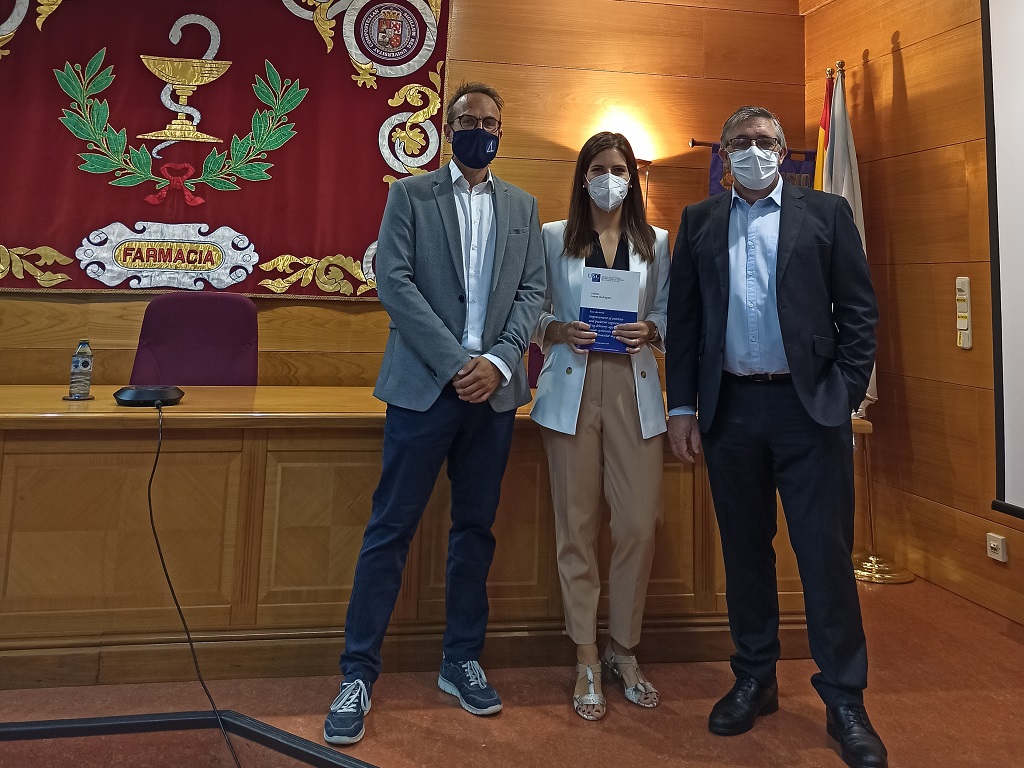Andrea Luaces Rodríguez, researcher from the IDIS pharmacy group and from USC, presented her doctoral thesis entitled “Improving the administration of drugs in the anterior and posterior segment of the eye: application in ocular cystinosis and in macular degeneration associated with age”. The work focuses on optimizing the treatment of two ocular diseases, a rare ailment called ocular cystinose and the pathology of high socioeconomic impact, age-related macular degeneration (AMD).
On the one hand, she developed a cysteamine ophthalmic hydroxel which came to be used as a master approach in most Spanish hospitals to treat pediatric patients with ocular cystinosis. For this, her thesis collected a broad and strict characterization of the approach developed which presented better characteristics in terms of residence time, tolerance, stability and adherence compared to the classically used cysteamine solution. Her development had a great impact on both a scientific and healthcare level since it allowed access to treatment to a greater number of patients and with a reduction in its cost.
On the other hand, she studied a new methodology based on a molecular image to determine the pharmacokinetics of compost administered by intravitreal injection of drugs. Thanks to this method, and by means of advanced techniques of radiolabeling of antibodies, she determined or pharmacokinetic profile of two antibodies used for the treatment of AMD in animal models, which it provided valuable information for the establishment of posoloxies of new intravitreal medications, as well as for a characterization of drug delivery systems.
In this sense, in addition, she began a line of research towards the development of an implant that will allow a controlled release of antibodies and thus to reduce the number of intravitreal injections to which patients are subjected. Treatment of AMD requires that patients receive intravitreal injections every one to two months with associated adverse reactions. In addition, the high cost of these treatments, together with the high incidence of AMD among the population, means that the possibility of having a treatment such as the exposed implant has a great impact both on the quality of life of patients and on an economic level in the healthcare field.
The results collected in her doctoral thesis led to five papers published in prestigious high-impact scientific journals in the field of pharmaceutical research and ophthalmology, such as the “International Journal of Pharmaceutics” and “Investigative Ophthalmology & Visual Science” . The Ph.D. Thesis was directed by Francisco J. Otero Espinar, professor and dean of the Faculty of Pharmacy, and Ángel Fernández Ferreiro, specialist in Hospital Pharmacy and Juan Rodes researcher at the Hospital Clínico Universitario de Santiago. The works were developed between the Faculty of Pharmacy of the USC, the Pharmacy Service and the Health Research Institute of Santiago de Compostela (IDIS), with the collaboration of the Molecular Imaging Unit. These investigations were developed thanks to projects financed by the Spanish Society of Hospital Pharmacy, the Mutua Madrileña Foundation, the Instituto de Salud Carlos III and Fundación A lucha de Iker contra la cistinosis ocular.





